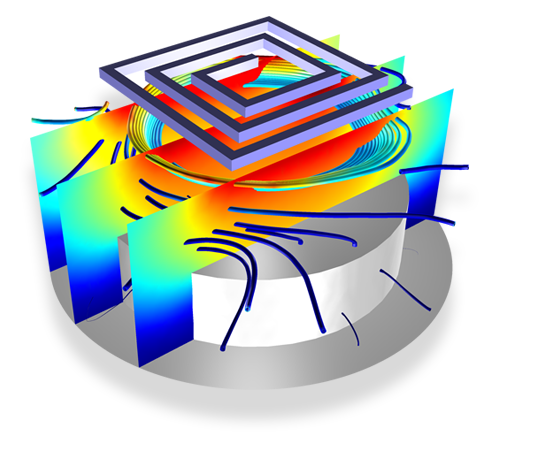
The Plasma Module is tailor-made to model and simulate low-temperature plasma sources and systems. Engineers and scientists use it to gain insight into the physics of discharges and gauge the performance of existing or potential designs. The module can perform analysis in all space dimensions – 1D, 2D, and 3D. Plasma systems are, by their very nature, complicated systems with a high degree of nonlinearity. Small changes to the electrical input or plasma chemistry can result in significant changes in the discharge characteristics.
Low-temperature plasmas represent the amalgamation of fluid mechanics, reaction engineering, physical kinetics, heat transfer, mass transfer, and electromagnetics – a significant multiphysics system, in other words. The Plasma Module is a specialized tool for modeling non-equilibrium discharges, which occur in a wide range of engineering disciplines. The Plasma Module consists of a suite of physics interfaces that allow arbitrary systems to be modeled. These support the modeling of phenomena such as: direct current discharges, inductively-coupled plasmas, and microwave plasmas. A set of documented example models, with step-by-step descriptions of the modeling process, along with a user’s guide accompany the Plasma Module.
This model simulates a negative corona discharge occurring in between two co-axially fashioned conductors. The negative electric potential is applied to the inner conductor and the exterior conductor is grounded. The modeled discharge is simulated in argon at atmospheric pressure.
This model simulates electrical breakdown in an atmospheric pressure gas. Modeling dielectric barrier discharges in more than one dimension is possible, but the results can be difficult to interpret because of the amount of competing physics in the problem.
In this simple model the problem is reduced to 1D by assuming the dielectric gap is much smaller than the diameter of the plates. To highlight the physics of the breakdown process, the model uses a simple argon chemistry, which keeps the number of species and reactions to a minimum.
The GEC cell was introduced by NIST in order to provide a standardized platform for experimental and modeling studies of discharges in different laboratories. The plasma is sustained via inductive heating. The Reference Cell operates as an inductively-coupled plasma in this model.
This model investigates the electrical characteristics of the GEC reference cell for argon chemistry.
This model simulates a plasma at medium pressure (2 torr) where the plasma is still not in local thermodynamic equilibrium. At low pressures the two temperatures are decoupled but as the pressure increases the temperatures tend towards the same limit.
Wave heated discharges may be very simple, where a plane wave is guided into a reactor using a waveguide, or very complicated as in the case with ECR (electron cyclotron resonance) reactors. In this example, a wave is launched into reactor and an Argon plasma is created. The wave is partially absorbed and reflected by the plasma which sustains the plasma.
The NIST Gaseous Electronics Conference has provided a platform for studying Capacitively Coupled Plasma (CCP) reactors, which is what this application is based upon.
The operating principle of a capacitively coupled plasma is different when compared to the inductive case. In a CCP reactor, the plasma is sustained by applying a sinusoidal electrostatic potential across a small gap filled with a low pressure gas (typically 1 Torr and in this case, the gas is Argon). The mechanism of power deposition into a CCP reactor is highly nonlinear and the system needs sufficient RF cycles in order to reach a periodic steady-state solution.
This application allows the user to provide inputs to configure the properties of both the plasma and the dielectric along with general operation inputs such as the physical dimensions of the cell, the number of RF cycles and driving frequency and voltage.
Plots show time/period averaged data and instantaneous data over the last RF cycle, along with excited species evolution. Animations of the time-averaged data are also available. Furher, the CCP Simulator returns period-averaged deposited power and the peak current.
The underlying physics of a capacitively coupled plasma is rather complicated, even for rather simple geometric configurations and plasma chemistries. This model benchmarks the Capacitively Coupled Plasma physics interface against many different codes.
Surface chemistry is often the most important and most overlooked aspect of reacting flow modeling. Surface rate expressions can be hard to find or not even exist at all. Often it is preferable to use sticking coefficients to describe surface reactions because they can be estimated intuitively.
The tutorial model simulates outgassing from a wafer during a chemical vapor deposition (CVD) process. Careful attention is paid to the overall mass balance in the system and the difference between the mass averaged velocity and diffusion velocity is explored.
One of the most useful quantites of interest after solving a self-consistent plasma model is the ion energy distribution function (IEDF). The magnitude and shape of the IEDF depends on many of the discharge parameters; pressure, plasma potential, sheath width etc. At very low pressures the plasma sheath is said to be collisionless, meaning that the ion energy is not retarded by collisions with the background gas. At higher pressures the ions collide with the background gas molecules in the sheath and their energy at the moment of impact with a surface is reduced. This model requires the Particle Tracing Module.